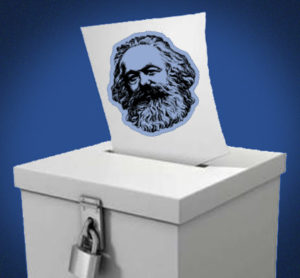A Possible Road to Independent Leftist Electoral Action

 Some months ago, a Gallup poll established that a majority of Americans, 57%, believe there is a need for a third major political party. Granted, this particular poll says nothing about the political orientation of this hypothetical third party. But given how other polls have made it clear that “fewer than half of young Americans view capitalism positively,” it should be obvious that at least most millennials want to vote for a party of the left that promotes — at least — robustly social-democratic policies, which the Democratic Party is not.
Some months ago, a Gallup poll established that a majority of Americans, 57%, believe there is a need for a third major political party. Granted, this particular poll says nothing about the political orientation of this hypothetical third party. But given how other polls have made it clear that “fewer than half of young Americans view capitalism positively,” it should be obvious that at least most millennials want to vote for a party of the left that promotes — at least — robustly social-democratic policies, which the Democratic Party is not.
At the moment, Democratic Socialists of America is divided over what an effective socialist electoral strategy should look like. The barriers to forming an independent left-wing party with a chance at winning many seats at the national level are considerable: a combination of winner-take-all, single-member district elections instead of proportional representation in the House of Representatives and their state equivalents; extremely difficult party qualification requirements that vary from state to state; a presidential rather than a parliamentary electoral system; the existence of U.S. parties as state-run ballot lines with no real members except those who get elected on said ballot lines; and the two-party monopoly (or duopoly) which both Democrats and Republicans agree on maintaining. All of this leads to an extraordinarily firm structural bias toward only two national parties being electorally viable in the U.S.
This was the justification for the “realignment” plan of both DSA and its precursor, the Democratic Socialist Organizing Committee (DSOC), to turn the Democratic Party into a social-democratic party. Of course, despite our best efforts, along with those of the most principled left-liberals, realignment didn’t occur. At least since 1993, DSA’s de facto electoral strategy has been “throw everything at the wall and see what sticks.” This usually means working for progressives who run in Democratic Party primaries (if said progressives are socialists and are loud about it, that’s even better), with occasional support for progressives who run as independents or Greens where those candidates have a serious chance at winning their races.
But this never constituted an actual strategy. On the contrary, it reflected DSA’s lack of a strategy. No “end-goal” was every clearly articulated. Furthermore, the innate flaws of the realignment strategy were never interrogated.
DSA members historically pointed out that the lack of a “tight” structure in the Democratic Party, with little party disciplining of its “members,” meant that when leftists, relying on “people’s cash” rather than corporate cash, run as Democrats, this isn’t some kind of betrayal of the working class. I agree. But precisely how is it possible to realign what isn’t even a real party — an independent organization with a clearly defined structure and dues-paying “ordinary” members — in the first place? How does one change a non-party into a party?
Furthermore, the realignment strategy was always excessively electoralist, with little vision beyond electoral gains for building a broader left movement. It effectively said that progressives winning every single Democratic primary, and every general election, was DSA’s greatest priority. This is wrong.
Electoral work is important; it’s a vital sphere of struggle and education and even power. Moreover, at the existing level of social consciousness, electoral victories make the left seem like a credible force in American society. But winning government elections should never be priority number one. It matters, but it’s not as if we’re going to change which social class runs society through executive signatures on bills. Only a broad, mass grassroots movement can do that. The realignment strategy was innately wrong-headed in the first place if one sees socialism as a necessary goal and not merely an ethical ideal or humanity’s best possible option.
The question is: how DSA can pursue an electoral strategy that isn’t “electoralist” and has a chance of overcoming the “Democratic Party problem?” Here are my thoughts.
After Realignment – What?
Despite DSA no longer having an official commitment to realigning the Democratic Party, an increasing number of DSA members are running for office as dissident Democrats. Given that in most cases, there’s little choice in the matter (one runs as a Democrat or else one runs as a candidate that probably won’t even have an effect on the outcome of the race, let alone win the race), I am not completely opposed to this. But this doesn’t constitute a full electoral strategy. DSA still does not have one.
It does seem that an increasing number of DSA members advocate a “dirty break” with the Democratic Party, a plan recently articulated by Eric Blanc to use the Democratic ballot line right now in a way that can eventually implode the two-party system. This is closely related to the widely read Jacobin article by Seth Ackerman which advocates a sort of “party within a party” approach: creating a left-wing, dues-paying membership organization (which would consist not only of DSA but also members of grassroots activist groups of different types and would be supported by the best existing unions) that “would have chapters at the state and local levels, a binding program, a leadership accountable to its members, and electoral candidates nominated at all levels throughout the country…[and] all candidates would be required to adhere to the national platform.”
Of course, this real party, presumably, would usually run candidates on the Democratic ballot line, at least initially. This is understandable, but it leaves unanswered the question of when in the future the “dirty break” will happen. It leaves socialists with a sort of halfway-house between “realignment” and full-blown independent political action.
How do we translate the ideal of a “dirty break with the Democrats,” which currently exists (so to speak) in a future that may never come, with a real prospect of independent leftist electoral politics?
I offer a provisional perspective, extrapolated from what worked for Bernie Sanders in Vermont. Let DSA members run in Democratic primaries – not to win as Democrats, but to lock the Democratic establishment from running a candidate against them. In other words, if our candidate wins, let them be in office, change their affiliation from “Democrat” to “Independent,” and run again as independents, but do so unopposed on the center-left.
Sanders regularly runs in the Vermont Senate Democratic primary, wins, then refuses the nomination and runs (again) as an Independent. I am arguing that DSA members running for office should engage in a variant of what Sanders does. Those who have already won office as Democrats ought to also drop the “D” next to their name and put an “I” in its place. To the best of my knowledge, this is legal in all 50 states. We might ask our not-quite-socialist elected allies to do the same. Then we’ve “locked out” the corporate-funded Democrats. After all, how dare they run as spoilers! Do they want the Republicans to win?
Getting many unions to back this strategy will be a struggle. It will require a radically different labor movement: one that is class-conscious, militant, and more sympathetic to independent political action. But that’s what the rank-and-file strategy is focused on: radically changing, expanding, and improving organized labor.
It seems clear to me that there currently exists a mass base for left-wing policies, for radical reform: increasingly disaffected with the status quo, but unable to see much beyond the Democrats — largely out of justifiable fear of the Republicans and the “spoiler problem.” The strategy I’m suggesting eliminates the spoiler issue, while remaining answerable to this base (much like what Ackerman describes), and the fundraising apparatus (DNC, DCCC, etc.) of the establishment Democrats becomes irrelevant. DSA and our progressive allies would also simultaneously urge independent-minded voters to support a membership stream of dues that provides funds for candidates who refuse to accept corporate donations, and then use that stream to fund left-wing independents who run in Democratic primaries and promise to run again as independents should they prevail, and also for independent candidates in places where no independent arises with the Democratic primary system.
And yes, we should ask DSA members who have already won office as Democrats to change the letter after their names from (D) to (I). I don’t know if all of them, or any of them, will do this. But we should ask anyway. It’s a crucial step towards actually breaking with the Democrats: even if we aren’t able to fully break with running candidates as Democrats immediately, we are making clear through our “Democrat turned Independent” strategy that we do want to move outside the Democratic ballot line as soon as possible.
Conclusion
What I’ve sketched in this essay may be the only way to introduce truly independent leftist political action into the U.S. electoral system. I don’t claim it is “the” answer. But to me it seems both feasible and desirable.
What the Green Party and others have been trying to do for decades clearly doesn’t work. It can’t overcome the structural barrier of the two-party system. But realignment is dead and merely doing the “dissident Democrat” thing won’t automatically lead to a break with the Democrats at some unknown point in the future. What I’ve outlined can make the dirty break begin now. It can block the “real” Democratic Party as an electoral competitor, so that the left-wing vote isn’t divided.
Special thanks to DSA member Barry Finger for his help in articulating this strategy in the first place – I’m merely expanding upon his ideas.
Originally posted, in slightly different form, at DSA’s Socialist Forum.